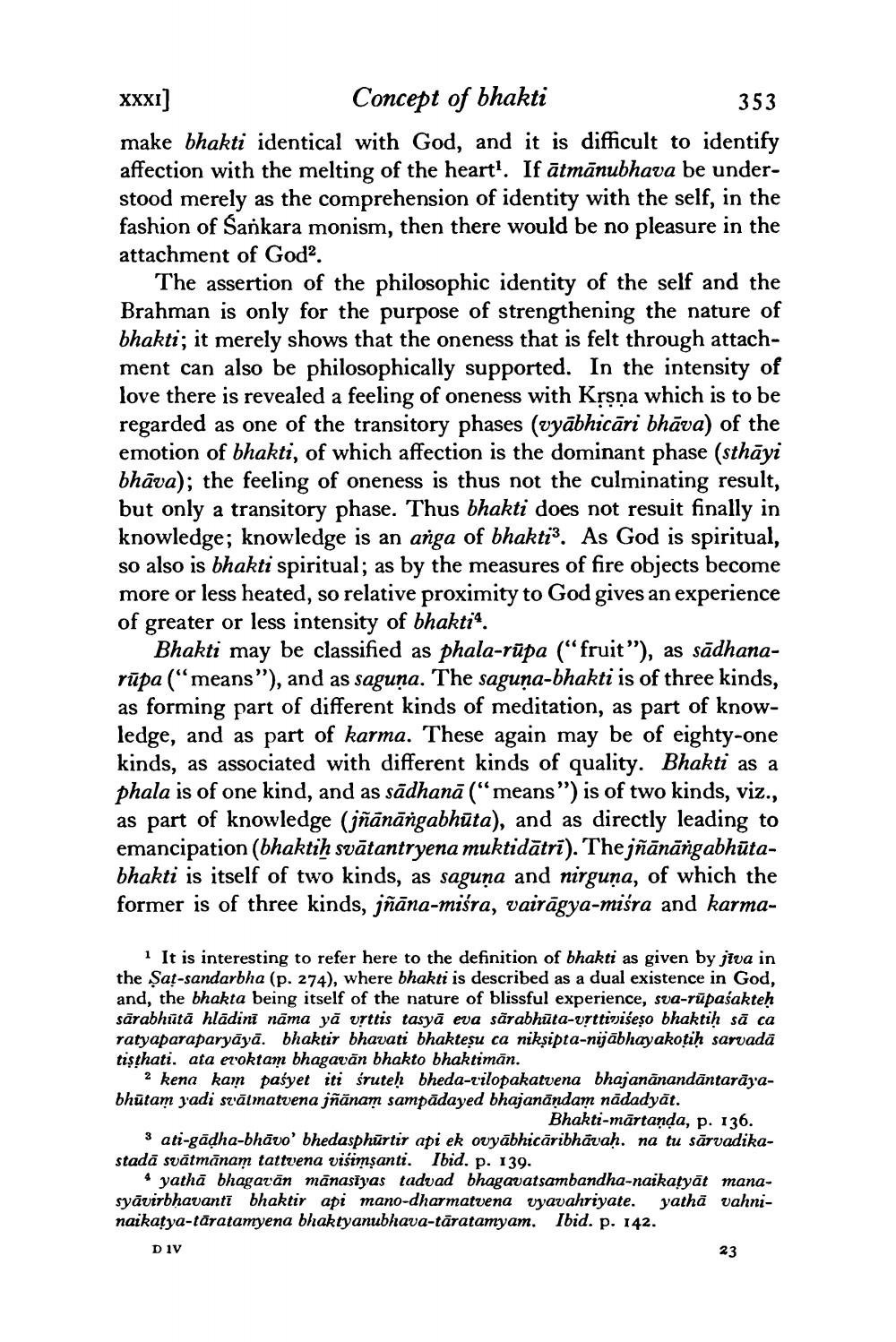________________
XXXI] Concept of bhakti
353 make bhakti identical with God, and it is difficult to identify affection with the melting of the heart'. If ātmānubhava be understood merely as the comprehension of identity with the self, in the fashion of Sankara monism, then there would be no pleasure in the attachment of God.
The assertion of the philosophic identity of the self and the Brahman is only for the purpose of strengthening the nature of bhakti; it merely shows that the oneness that is felt through attachment can also be philosophically supported. In the intensity of love there is revealed a feeling of oneness with Krsna which is to be regarded as one of the transitory phases (vyābhicāri bhāva) of the emotion of bhakti, of which affection is the dominant phase (sthāyi bhāva); the feeling of oneness is thus not the culminating result, but only a transitory phase. Thus bhakti does not result finally in knowledge; knowledge is an anga of bhakti3. As God is spiritual, so also is bhakti spiritual; as by the measures of fire objects become more or less heated, so relative proximity to God gives an experience of greater or less intensity of bhakti".
Bhakti may be classified as phala-rüpa ("fruit"), as sādhanarūpa (“means”), and as saguna. The saguna-bhakti is of three kinds, as forming part of different kinds of meditation, as part of knowledge, and as part of karma. These again may be of eighty-one kinds, as associated with different kinds of quality. Bhakti as a phala is of one kind, and as sādhanā (“means ") is of two kinds, viz., as part of knowledge (jñānāngabhūta), and as directly leading to emancipation (bhaktih svātantryena muktidātri). The jñānāñgabhūtabhakti is itself of two kinds, as saguna and nirguna, of which the former is of three kinds, jñāna-mišra, vairāgya-miśra and karma
i It is interesting to refer here to the definition of bhakti as given by jiva in the Șat-sandarbha (p. 274), where bhakti is described as a dual existence in God, and, the bhakta being itself of the nature of blissful experience, sva-rūpasakteh sārabhūtā hlādini nāma yā vrttis tasyā eva sārabhūta-urttiviseso bhaktih să ca ratyaparaparyāyā. bhaktir bhavati bhakteņu ca nikṣipta-nijābhayakotiḥ sarvadā tişthati. ata eroktam bhagavān bhakto bhaktimān.
2 kena kam paśyet iti śruteh bheda-vilopakatvena bhajanānandāntarāyabhūtam jadi stālmatvena jñānam sampadayed bhajanandam nādadyāt.
Bhakti-mārtanda, p. 136. 3 ati-gādha-bhāvo' bhedasphurtir api ek ovyābhicäribhāvah. na tu sārvadikastadā svātmānam tattvena visimşanti. Ibid. p. 139.
4 yathā bhagavān mānasiyas tadvad bhagavatsambandha-naikatyāt manasyāvirbhavanti bhaktir api mano-dharmatvena vyavahriyate. yathā vahninaikatya-tāratamyena bhaktyanubhava-tāratamyam. Ibid. p. 142. DIV
23




